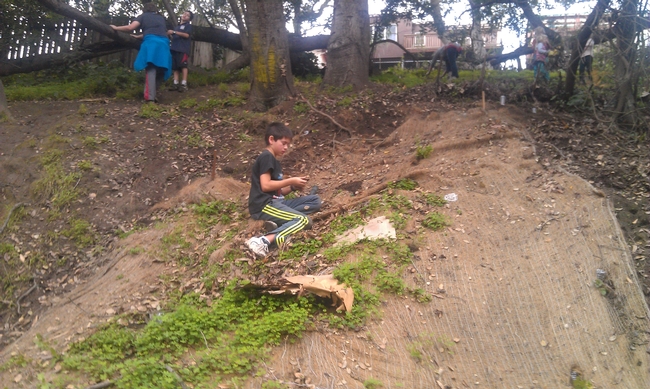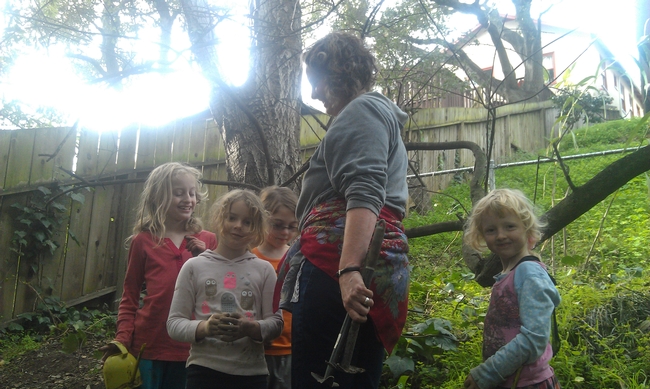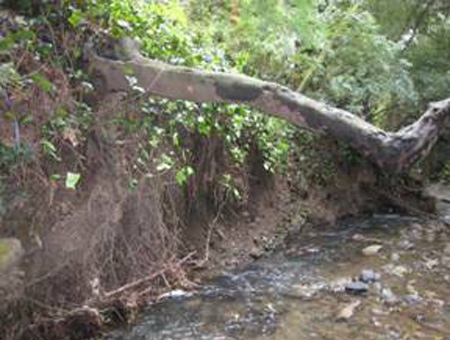4-H club restores Sausal Creek with native plants

Since adopting the stretch along Sausal Creek in Dimond Park in 2012, 20 4-H members ranging from 5 to 12 years old have been pulling out the invasive plants and replacing them with native plants.
“Friends of Sausal Creek provides us with all the plants and gives us guidance on what should go where,” said Genesta Zarehbin, the 4-H adult volunteer leading the project.
“We planted lots of native plants, such as strawberries, bee plant, ninebark, iris-leaf rush, wood rush, and thimbleberry, that look really cool — but it still gives the appearance of more ivy and spiderwort,” said Zarehbin, who lives in Oakland.

“They have field journals and do research to complete a plant page,” Zarehbin said. “The younger kids do observation -- how many leaves does it have? What color is it? How tall is it? It's a natural discussion when you're out there.”
After removing the invasive, nonnative plants, the 4-Hers had the opportunity to redesign the stretch of trail by choosing and planting natives. At monthly meetings held at the creek, the members regularly weed, water and mulch the plants and pick up trash.
“My kids really get into it,” said Zarehbin, whose children include 9- and 11-year-old sons and twin 6-year-old daughters. “They recognize cow parsnip and soaproot when we go out on hikes. In some areas they'll say, ‘This looks like people are taking care of it.' It gives them a sense of place and how humans shape the environment.”

“The first year, everything died,” said Zarehbin. “The second year, we supplemented the water, and we have a number of plants that survived.”
The creek project is educating the 4-H members, and the 4-H members, in turn, are educating park visitors about the vital work of protecting our natural resources.
“Since our work site is in a very visible location, our 4-H members have been able to enlist the assistance of community members and they frequently have the opportunity to share information with curious onlookers,” said the 4-H project leader.
Zarehbin appreciates the autonomy that Friends of Sausal Creek has allowed, something that enables the kids to develop a sense of ownership. “They let the kids control how they want things to look,” she explained. “The Friends of Sausal Creek are willing to work with young kids and let them work hands-on and contribute in a meaningful way.”

The organization often leads middle school and high school students on field trips, but 4-H is one the few long-term relationships they have with younger children.
Friends of Sausal Creek, which manages a 2600-acre watershed with two permanent full-time staff members, depends on the help of others to preserve and protect the creek.
Groups typically work on an adopted site a few times a year, whereas the 4-H members tend to their site at least once a month. At the last 4-H work day, 30 people participated, said Zarehbin.
“Their recurring workdays enable them to maintain the site – weeding around the native plants and watering them until they are established,” said McAfee. “Their work helps to increase the biodiversity in these urban wildlands.”
McAfee hopes the kids' enthusiasm for nurturing the natural environment will spread to other people in the community.

Every year the 4-H club hosts an Earth Day event for a local public school to share what they're learning with other kids their age. Last year, 90 students from Sequoia Elementary School participated, making nature-based crafts and pulling invasive plants to widen the trail. This year the 4-H members have invited Glenville Elementary to join them at Dimond Park on March 12 from 11 a.m. to 1 p.m.
To learn more about participating in 4-H in Alameda and Contra Costa counties, contact May McMann, 4-H program representative at mmcmann@ucanr.edu or (925) 646-6543. To find a UC Cooperative Extension 4-H club near you, visit http://4h.ucanr.edu/Get_Involved/County.
For more than 100 years, the University of California Cooperative Extension researchers and educators have been drawing on local expertise to conduct agricultural, environmental, economic, youth development and nutrition research that helps California thrive. UC Cooperative Extension is part of the University of California's systemwide Division of Agriculture and Natural Resources. Learn more at ucanr.edu.